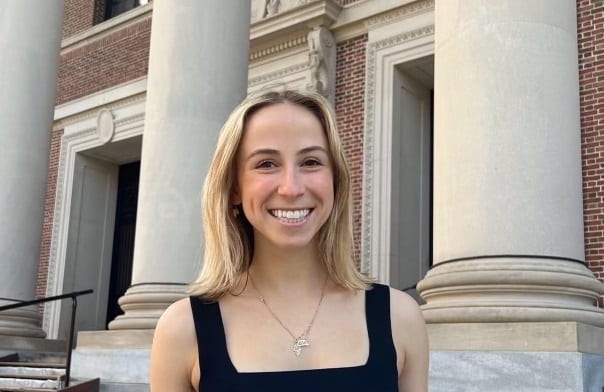The Center for Jewish Studies at Harvard University is pleased to announce the recipients of the 2022 Selma and Lewis Weinstein Prize in Jewish Studies. Shoshana F. Boardman ’22, a senior in Winthrop House, was awarded first place for her essay “Babylonian Incantation Bowl Onomastics.” Sonia F. Epstein ’22, a senior from Eliot House, submitted “To Build and To Be Built: Tuberculosis Control and the Zionist Movement, 1922-1957″ which won the second-place prize. Hannah Mae Miller ’22, a senior in Quincy House, received a special citation for her entry, “Let My People Go! The Movement for Soviet Jewish Emigration’s Impact on US Human Rights Policies 1963-1975.” The Weinstein Prize, which is given to the Harvard University student(s) who submits the best undergraduate essay in Jewish studies, was established by Lewis H. Weinstein ’27, LL.B. 1930.

Shoshana Boardman ’22
First Prize
“Babylonian Incantation Bowl Onomastics.”
Abstract:
This thesis investigates the naming conventions of late antique Jewish Babylonian communities. These communities were among the strongest and most influential in Jewish history. They codified the mammoth text known today as the Babylonian Talmud, a text which colors much of our understanding of Jewish life in this period. However, the authors of the Talmud were a male, educated elite. They often perceived themselves as categorically distinct from less educated, or more acculturated, Jews, and rarely centered on these latter voices. Luckily, there is another—and only one other—large source of textual evidence for the experiences of these non-rabbis: the incantation bowls, found in the 1890s buried under doorframes. The spells written on these bowls were to protect households from malevolent entities. As they were written or commissioned by women and practitioners of magic, quote texts and mention names affiliated with multiple religions, and are free of the generations of ideological “hypercorrections” in the Talmud, they allow us the often unattainable privilege of access to voices left out of the canon. In this thesis, I argued that these voices represent Jewish communities distinct from those of the Talmud. I analyzed client names in 214 incantations, assessing their demographic factors (gender, language of origin, religious associations, family relationships, etc.). My study of onomastics in magical texts constitutes a methodological intervention. The data points to an integrated community, with a preference for Semitic-named parents to pass down a Semitic naming tradition to their children. This suggests that some Jewish practice was preserved among bowl clients. By comparing this data to the highly Semitic names in the Talmud, we see that the bowls represent a different way to be Jewish in late antiquity.
Sonia Epstein ’22
Second Prize
“To Build and To Be Built: Tuberculosis Control and the Zionist Movement, 1922-1957”

Abstract:
The Zionist movement and the campaign against tuberculosis emerged simultaneously in Palestine during the twentieth century, yet there has been no comprehensive study of their coterminous history. By analyzing tuberculosis as both a cultural and material force, I elucidate how efforts to control a chronic, emaciating disease gained ideological resonance within the Zionist movement and contributed to the development of a divided, unequal medical system under British colonial rule. Zionist efforts to combat tuberculosis expanded throughout the Mandate period and after Israel’s founding not merely as a result of the disease’s increasing prevalence, but because these efforts powerfully signified Jewish rejuvenation, productivity, and “civilization.” Examining the ways Zionism and tuberculosis control enabled and reproduced each other sheds light on how social and political divides were deepened and defined between Palestinian Arabs and Jews, and among Jews themselves. This history, which draws upon English- and Hebrew-language archival materials from the British National Archives, Hadassah Medical Organization, scientific and governmental actors, and foreign and local observers, ultimately demonstrates that the nation-building process is sustained equally by institutional construction and self-construction, processes that continuously inform each other, shaping the very possibilities that e tiquity.

Hannah Mae Miller ’22
Special Citation
“Let My People Go! The Movement for Soviet Jewish Emigration’s Impact on US Human Rights Policies 1963-1975”
Abstract:
Richard Nixon and Henry Kissinger entered office hoping to strengthen US-Soviet détente by brokering nuclear arms limitation and trade agreements with the USSR. Given that the Soviet Union was intent on expanding its nuclear arsenal, many Americans were relieved that the administration would relax its antagonism to the Soviet Union to avert a potential nuclear war. However, Jewish Americans saw renewed US-Soviet relations as an opportunity to combat Soviet anti-Semitic policies, most notably limitations on Jewish emigration. American Jewish activists mobilized to create a bipartisan alliance between Democrats and Republicans in support of legislation to promote Soviet Jews’ human rights. They grew unanimous support for the Jackson-Vanik Amendment to the Trade Act of 1974, an amendment to link US-Soviet economic agreements to the condition that the Soviet Union permit free Jewish emigration. In doing so, American Jewry introduced the idea that the US has a moral imperative to protect international human rights as part of US foreign policy debates. Their efforts have had lasting consequences on US foreign policy and created the groundwork for future US human rights legislation. This essay demonstrates how Jewish activists successfully mobilized to challenge US foreign policy, how the movement to free Soviet Jewry unleashed new tensions between US Cold War strategy and a desire to promote international human rights, and how this movement inspired future US human rights legislation.
